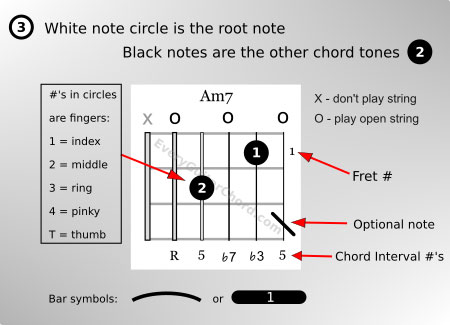If you like crunchy sounding chords with a strong tendency to resolve to the tonic, then you should learn the suspended Phrygian chords 7sus ♭9 and 13sus ♭9. The 7sus ♭9 chord is built from the Phrygian mode of the major scale and the 2nd mode of the Melodic minor scale. The 13sus ♭9 chord can only be built from the melodic minor scale. I cover both chords in detail and have 6 open guitar chord shapes for G7sus ♭9 and G13sus ♭9.
What is a Phrygian Chord
A Phrygian chord is defined as a dominant 7th suspended chord that also has a flat 9 in the chord. There are really only two possibilities – 7sus ♭9 and 13sus ♭9. It is the ♭9 that distinguished the Phrygian mode of the major scale from the Aeolian mode.
Phrygian mode degrees: 1-♭2-♭3-4-5-♭6-♭7
Aeolian mode degrees: 1-2-♭3-4-5-♭6-♭7
Although both modes differ by only one note, the minor 2nd versus the major 2nd, that one note is a huge difference. The Phrygian mode is closer to the Locrian mode than the Aeolian mode, in my opinion.
And when it comes to Phrygian chords, you do not add the ♭9 to the minor triad or minor 7th chord. For example, a Gm7♭9 chord is just an inversion of a B♭13 chord. I’ve never seen anyone use a Gm add ♭9 chord but I suppose you could use that one
What you do instead is add the ♭9 to the 7sus chord. There are only 2 modes where you can build the 7sus ♭9 chord: 3rd mode of the major scale and the 2nd mode of the melodic minor scale.
You can use the Phrygian mode to improvise over a Phrygian chord, but you can use the chords wherever you want. For example, instead of using the E7sus ♭9 chord in the key of C major, you could substitute it as the V7 chord in A major. See the next section for the resolution tendencies of these chords.
G7sus b9 & G13sus b9 chords in detail
The 7sus ♭9 chord is built on the iii of the major scale and the ii of the melodic minor scale. As an example in G, For G that would be E♭ major and F melodic minor.
I notate the chord as 7sus ♭9 but you may also see 7sus♭9, 7sus(♭9), G Phryg, Gdom7 sus(♭9), or some variation of that.
G7sus ♭9 chord tones: G-C-D-F-A♭
G7sus ♭9 intervals: R-P4-P5-m7-m2 = 1-4-5-♭7-♭9
Equivalent chords: G7sus ♭9 = Fm6 add9= Dm11♭5
G13sus ♭9 chord tones: G-C-D-F-E-A♭
G13sus ♭9 intervals: R-P4-P5-m7-M6-m2 = 1-4-5-♭7-13-♭9
The tendency for both chords is strongest to E♭ major, but also to A major. Also try going to A♭, C, D & E major. The resolution for those keys works even though it is not due to the tritone in the chord.
Open G7sus Phrygian chords
I only have 3 chord shapes for each chord and a couple of them are hard to hold. Here is a chart explaining the symbols on my chord diagrams:







Final Thoughts
Not much to say here other than give the chords a try and see if you like them. Check out my G7sus Guitar Chords article for open chord shapes for G7sus, G9sus, and G13sus.




